Chulent is basically Jewish stew. At least that’s the Yiddish/Ashkenazi name for it. In the Sephardic world, it’s called hamin, which makes more sense to me because it means hot. According to Orthodox Jewish Law, you can’t cook on Shabbat, so it’s a great way to make hot food. You basically stick everything in a crockpot and serve it the next day.
I remember the first time that I had chulent. I was 10 years old and my family was just starting to become religious. We spent Shabbat at Rabbi and Mrs. Charner’s house and they served this potato, barley, bean and meat concoction. It tasted amazing.
There are all sorts of chulents out there. For years, even before going vegan, I’ve been making a vegetarian chulent. The meat part of the chulent never spoke to me. I would try to avoid it and just eat the barley and potatoes anyway. That’s why, not only is my chulent meatless, it is also beanless.
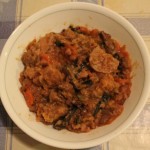
- Prep Time: 20 minutes
Chulent (aka Hamin)
Perfect for a winter Shabbat.
Ingredients
- potatoes - 6 pealed and chopped
- sweet potato - 1 large, pealed and chopped
- onion - 1, chopped
- carrots - 3, chopped
- celery stalks - 2, chopped
- shitake mushrooms - 1 cup, chopped (optional)
- TVP - 2 cup (optional)
- barley - 1 cup
- ketchup - 1/2 cup
- brown sugar - 1/4 cup
- vegetable bouillon - 4 tablespoons
- water
Instructions
- Chop up all the ingredients, and place in crockpot.
- Add enough water so that you can see the water from the top of the pot, without the water covering the chullent all the way.
- Mix everything up well.
- Set crockpot on low and let it cook for at least 12 hours.
- Serve.
Allergens
When I make chulent, I’ll start it early on Friday afternoon, and we don’t eat it until about 11 am the next day. As long as there is enough water, the longer it cooks, the more time the flavors have to meld together.
Whenever I make chulent, I have to make kishke. They just go together. Once you make the kishke, all you have to do is put it on top of the chulent and it will cook in the pot at the same time.
Just a warning – when you take the chulent out of the crockpot it is very hot. The first thing that I try to do when I get home from Saturday morning services (when I remember) is take the chulent out of pot so that it has a bit of time to cool before I serve it. Although it’s funny to watch people try to eat it when it is really hot, I don’t think it’s a good idea.
Add to Favourites
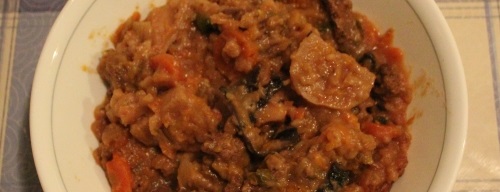
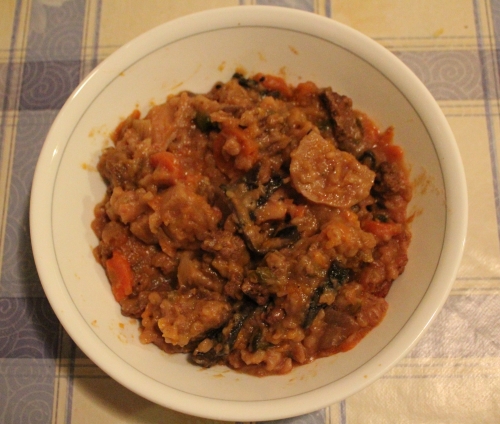
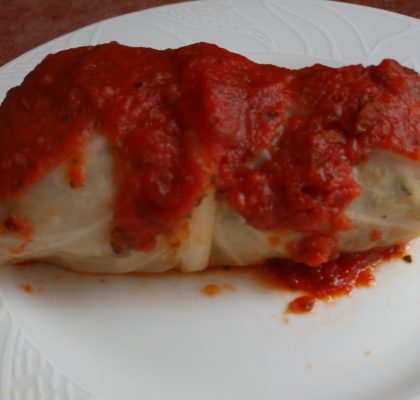
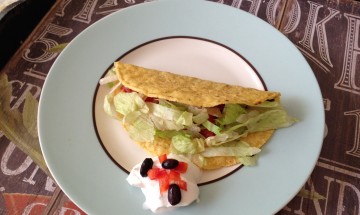
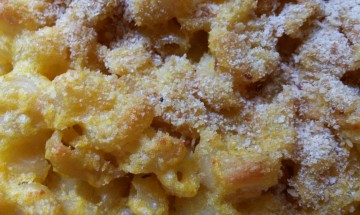
Cholent also means “hot”. That’s why a person who doesn’t get heated up is called “nonchalant”….
That is so cool. My Yiddish is very rusty (read non-existent). Do you have a blog post on it?
It’s been on my list of things to write about since I started the blog, but haven’t gotten around to it. Someday…
Thanks Rena for posting this….I shall get the ingredients tomorrow and make this….
Marsha
That’s so cool. Let me know how it comes out.
Hi Rena,
Oh my goodness, this Cholent was so delicious. I made a couple of changes. I added 4 cloves of garlic, salt, pepper, woostershire and instead of chicken soup (I didn’t have any) I had some veggie chicken gravy which I mixed in. The mock kishka was absolutely amazing also. (Although next time I shall make some mock schmaltz by caramelizing some sliced spanish onions in olive oil over a couple of hours…. and add this in place of the 3/4 cups of oil…this will give the kishka a more authentic taste)
Thanks so much for helping me to relive some of the most delicious parts of my youth.
Marsha
I know using imitation chicken bullion is a bit of a cheat. How much of each do you use? I’d love to know your recipe. I’m always looking to try new things.
My kids are especially fond of the kishke. What a great idea to make mock schamtz instead of the oil. I’m going to have to try it. Thanks!
Hi Rena,
I am a chef by trade, and I have done personal cheffing, managing a catering company and prepping for restaurants for many years. I actually don’t really measure. I cut the main ingredients of your cholent recipe in half and just put in what I felt would be a fair amount of my add-ons. I did add quite a bit of salt to make it taste good for me. The recipe made 2 meals for eating now, and 4 more for freezing, which included a healthy sized piece of kishka for each (Yum!).
I want to share with you my morning drink which is incredibly healthy. Into a Vita-Mix Blender I add 4 Tbsps of Kifir, 1/2 banana, 2 tablespoons hemp hearts, 1 cup kale, 1 cup spinach, 1 cup berries (I keep to one kind either blue, straw or rasp), 1/2 tsp aloe gel, 2 dates which were soaked in water overnight, and enough low fat vanilla soy milk to make it drinkable, and let it blend for about 1 1/2 minutes. It is a delicious drink to me, and I feel like I’ve given my body a remarkable gift. Then I go to the YMCA (which is 10 minutes from my home) and swim 30 lenghts of the pool. I am 63 years old and I feel and look …..”mmmmavalos!”
Marsha
OMG! I always feel great when people tell me that they like my recipes, but hearing that a chef likes them makes me feel even more special. You have made me set the bar even higher ;-).
I recently got one of those strong blenders (I looked all over Israel for a Vita-Mix blender, but they don’t seem to sell them here). Since I haven’t used it yet, I plan on using it over Passover. (I know, I have Passover on the brain). Things are getting a lot better in Israel, but there are still a lot of things that I haven’t been able to find. I don’t think that I’ve ever seen hemp hearts or kifir. I can sometimes find agar (is that aloe gel?) I’d love to try these things. I think that I’ll have to stock up on them on my next trip to the US so that I can try these kinds of recipes. It sounds really yummy and healthy.
I am totally impressed by you. I really need to get in shape. I walk with friends practically every day and do some other things on the side. I wish that I could do 2 pool lengths, forget about 30. You have inspired me to step up my game!
Hi Rena,
If you have a health food store in Israel than they have all the ingredients I mentioned. Kefir starter (similar to yogurt starter) can be purchased on line, here: http://www.culturesforhealth.com/ to me it sort of tastes like sour cream, but a bit more sweeter and tarter, if you can imagine. I imagine you have aloe vera plants where you live. It is a cactus and the gel is scraped from the inside of the leaves, and is then used to treat minor skin burns and other skin irritations, topically. It also has amazing health properties if a very small amount is taken internally. You can search this on the web. Hemp hearts can also be purchased on line.
Thanks for the kind words…
Ketchup in an Oriental dish?!! Sacrilege!
If you don’t want to use ketchup, feel free to use tomato paste. My mom always made her chulent with ketchup, so I grew up on it. I guess that’s what happens when you Americanize Oriental recipes. Don’t knock it too much, it tastes really good!